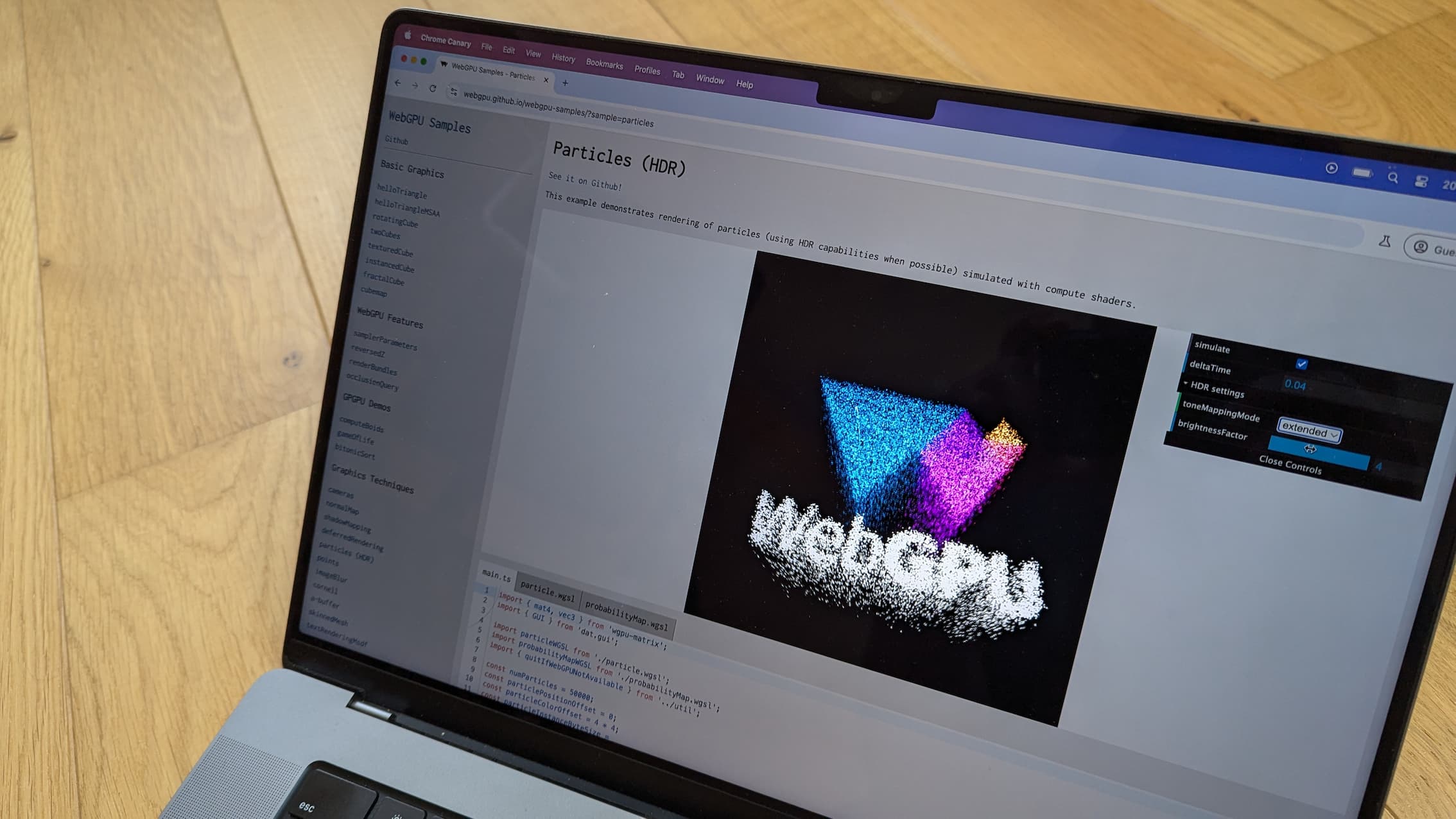支持 HDR,并采用画布色调映射模式
Web 开发者在提供 HDR 内容方面可选择的方案有限,主要依赖于 <img> 和 <video> 元素。不过,<canvas> 元素仍仅限于 SDR。在画布中生成动态 HDR 内容需要在显示之前将其内容编码为 HDR 图像(有关示例,请参阅此演示)。
WebGPU 画布配置中的新 GPUCanvasToneMappingMode 参数现在允许 WebGPU 绘制比白色 (#FFFFFF) 更亮的颜色。它通过以下模式实现此目的:
"standard":默认行为会将内容限制在屏幕的 SDR 范围内。此模式通过将屏幕颜色空间中的所有颜色值限制在[0, 1]区间内来实现。"extended":解锁屏幕的完整 HDR 范围。此模式与屏幕[0, 1]范围内的"standard"相匹配。对屏幕的扩展动态范围进行钳制或投影,但不进行[0, 1]。
以下代码段展示了如何配置高动态范围画布。
const adapter = await navigator.gpu.requestAdapter();
const device = await adapter.requestDevice();
const canvas = document.querySelector("canvas");
const context = canvas.getContext("webgpu");
context.configure({
device,
format: "rgba16float",
toneMapping: { mode: "extended" },
});
如需探索 WebGPU 的 HDR 功能,请查看粒子 (HDR) 示例和 WebGPU HDR 示例,并参阅 chromestatus 条目。

支持展开子群组
在子群组实验发布后,子群组内置函数现在可用于计算着色器和片段着色器。它们不再仅限于计算着色器。请参阅问题 354738715。
请注意,subgroup_size 内置值目前在 fragment 着色器中存在 bug。暂时避免。
此外,还添加了以下子群组内置函数:
subgroupAdd(value):返回子组中所有有效调用value的总和。subgroupExclusiveAdd(value):返回子群组中所有有效调用value的排他性扫描求和。subgroupMul(value):返回子群组中所有有效调用value的乘积。subgroupExclusiveMul(value):返回子群组中所有有效调用value的排他性扫描乘积。subgroupAnd(value):返回子组中所有有效调用value的二进制 AND。subgroupOr(value):返回子群组中所有有效调用value的二进制 OR 结果。subgroupXor(value):返回子群组中所有有效调用value的二进制异或结果。subgroupMin(value):返回子群组中所有有效调用value的最小值。subgroupMax(value):返回子群组中所有有效调用value的最大值。subgroupAll(value):如果子组中所有有效调用的value均为 true,则返回 true。subgroupAny(value):如果子组中任何有效调用的value为 true,则返回 true。subgroupElect():如果此调用在子组的有效调用中具有最低的subgroup_invocation_id,则返回 true。subgroupBroadcastFirst(value):将子群组中具有最低subgroup_invocation_id的有效调用的value广播到所有其他有效调用。subgroupShuffle(value, id):从subgroup_invocation_id与id匹配的有效调用中返回value。subgroupShuffleXor(value, mask):从subgroup_invocation_id与subgroup_invocation_id ^ mask匹配的有效调用中返回value。mask必须是动态统一的。subgroupShuffleUp(value, delta):返回subgroup_invocation_id与subgroup_invocation_id - delta匹配的有效调用的value。subgroupShuffleDown(value, delta):返回subgroup_invocation_id与subgroup_invocation_id + delta匹配的有效调用的value。quadBroadcast(value, id):从 ID 等于id的四次调用中广播value。id必须是常量表达式。quadSwapX(value):在四边形中沿 X 方向交换调用之间的value。quadSwapY(value):在四边形中沿 Y 方向交换调用之间的value。quadSwapDiagonal(value):在四边形中沿对角线交换调用之间的value。
“黎明”更新
wgpu::PrimitiveState 结构体现在直接包含深度剪裁控制设置,无需单独的 wgpu::PrimitiveDepthClipControl 结构体。如需了解详情,请参阅以下代码段和 webgpu-headers PR。
// Before
wgpu::PrimitiveState primitive = {};
wgpu::PrimitiveDepthClipControl depthClipControl;
depthClipControl.unclippedDepth = true;
primitive.nextInChain = &depthClipControl;
// Now
wgpu::PrimitiveState primitive = {};
primitive.unclippedDepth = true;
这仅涵盖了部分重要亮点。查看详尽的提交列表。
WebGPU 的新变化
WebGPU 新变化系列中涵盖的所有内容。
Chrome 143
Chrome 142
Chrome 141
Chrome 140
- 设备请求会消耗适配器
- 使用纹理视图时使用纹理的简写形式
- WGSL textureSampleLevel 支持一维纹理
- 弃用 bgra8unorm 只读存储纹理用法
- 移除了 GPUAdapter isFallbackAdapter 属性
- Dawn 更新
Chrome 139
Chrome 138
Chrome 137
- 使用纹理视图进行 externalTexture 绑定
- 复制缓冲区,但不指定偏移量和大小
- 使用指向原子变量的指针的 WGSL workgroupUniformLoad
- GPUAdapterInfo powerPreference 属性
- 移除 GPURequestAdapterOptions compatibilityMode 属性
- Dawn 更新
Chrome 136
Chrome 135
- 允许创建具有 null bind 组布局的流水线布局
- 允许视口超出渲染目标边界
- 更轻松地访问 Android 上的实验性兼容性模式
- 移除 maxInterStageShaderComponents 限制
- Dawn 更新
Chrome 134
Chrome 133
- 新增了 unorm8x4-bgra 和 1 分量顶点格式
- 允许请求具有未定义值的未知限制
- WGSL 对齐规则变更
- 使用 discard 获得的 WGSL 性能提升
- 针对外部纹理使用 VideoFrame displaySize
- 使用 copyExternalImageToTexture 处理具有非默认方向的图片
- 改善开发者体验
- 启用与 featureLevel 的兼容模式
- 清理实验性子群组功能
- 弃用 maxInterStageShaderComponents 限制
- Dawn 更新
Chrome 132
- 纹理视图使用情况
- 32 位浮点纹理混合
- GPUDevice adapterInfo 属性
- 以无效格式配置画布上下文时抛出 JavaScript 错误
- 纹理过滤采样器限制
- 扩展子群组实验
- 改善开发者体验
- 对 16 位归一化纹理格式的实验性支持
- Dawn 更新
Chrome 131
- WGSL 中的剪裁距离
- GPUCanvasContext getConfiguration()
- 点和线图元不得具有深度偏移
- 子群组的包含性扫描内置函数
- 对多重绘制间接的实验性支持
- 着色器模块编译选项“严格数学”
- 移除 GPUAdapter requestAdapterInfo()
- Dawn 更新
Chrome 130
Chrome 129
Chrome 128
Chrome 127
Chrome 126
Chrome 125
Chrome 124
Chrome 123
Chrome 122
Chrome 121
- 在 Android 上支持 WebGPU
- 在 Windows 上使用 DXC 而不是 FXC 进行着色器编译
- 计算和渲染通道中的时间戳查询
- 着色器模块的默认入口点
- 支持将 display-p3 用作 GPUExternalTexture 色彩空间
- 内存堆信息
- Dawn 更新
Chrome 120
Chrome 119
Chrome 118
Chrome 117
Chrome 116
- WebCodecs 集成
- 由 GPUAdapter
requestDevice()返回的丢失设备 - 在调用
importExternalTexture()时保持视频播放流畅 - 规范一致性
- 改善开发者体验
- Dawn 更新
Chrome 115
Chrome 114
Chrome 113
- 在
importExternalTexture()中使用 WebCodecs VideoFrame 来源


